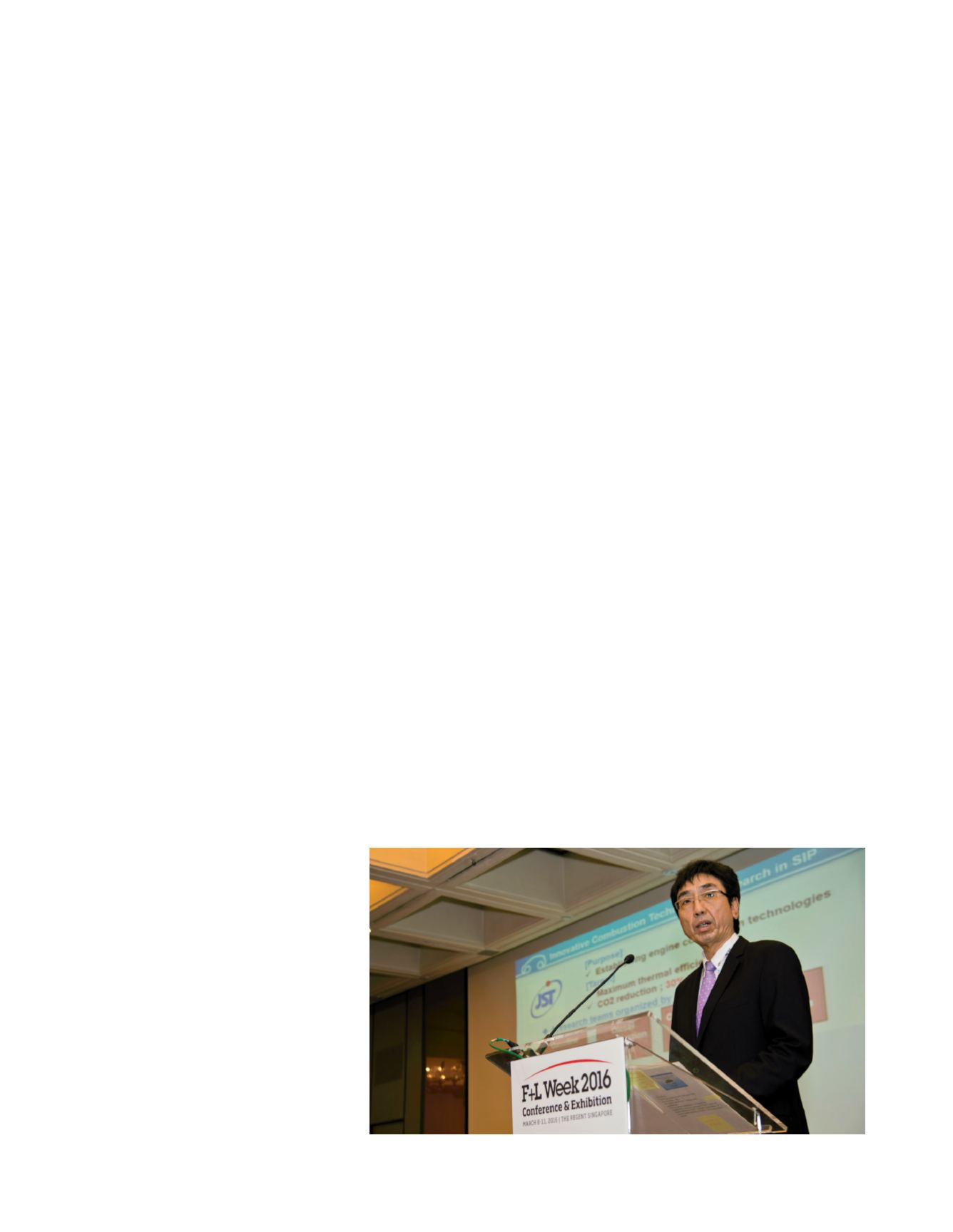
15
Fuels & Lubes International Quarter Two 2016
tion had begun to pick up, making
gasoline available. Of course, this
all meant that CO2 emissions have
climbed steadily.
Today, Sugiyama said, the auto-
motive society needs to diversify its
powertrains to include what he calls
next-generation vehicles. Hybrids,
electric vehicles and fuel cell vehi-
cles must be a part of the picture—a
much larger part— in the near
future, he said. However, he added,
“the internal combustion engine
is going to be the mainstream in
powertrains for a few decades.” By
2050, about 80% of light-duty vehicle
sales will have internal combus-
tion engines—this figure includes
hybrid vehicles and only excludes
fully electric and fuel cell vehicles,
he said. This data from the Interna-
tional Energy Agency (IEA) shows
a projected downslope in gasoline
engine vehicles after 2020, with
next-generation vehicles becoming a
larger percentage of the fleet.
While customers around the world
are accepting hybrid vehicles as a
viable option, Sugiyama said, “it has
taken a long time.” Toyota’s hybrid
vehicle, the Prius, which was intro-
duced in 1998 reached a milestone
of eight million units sold globally
only in July 2015. Hydrogen fuel cell
vehicles are at a much earlier stage
in their development. Toyota plans to
sell 30,000 units of the Mirai, Toyo-
ta’s fuel cell vehicle, by 2020. Its goal
for this year is 2,000 units and next
year is 3,000 units.
Toyota also acknowledged that it
cannot bring about its vision of a hy-
drogen society on its own. In January
2015, the company announced that
it would make its roughly 5,680 fuel
cell patents available, royalty-free,
to other automakers as well as fuel
cell marketers and developers.
Patents relating to fuel cell vehicle
development will be available until
2020, and those relating to hydrogen
supply and refueling will be open
indefinitely. Toyota’s decision is sim-
ilar to U.S. electric car manufacturer
Tesla’s decision in 2014, its goal
始大规模发展,提供了大量的汽油。当然,这也
就意味着二氧化碳的排放稳步攀升。
Sugiyama说,今天汽车界需要采用多种动
力系统,包括所谓的下一代汽车。混合动力、电
动汽车、燃料电池汽车必须成为汽车大家族的
成员,并在不远的未来成为重要成员。然而,他
又说:“内燃机在未来数十年间还将是主流动力
系统。”到2050年,所销售的80%的轻型汽车
还将使用内燃机——这个数字包括了混合动
力汽车,仅仅排除了纯电动汽车和燃料电池汽
车,他说。来自国际能源署(IEA)的数据表明,
预计2020年后汽油机汽车开始下降,下一代汽
车逐步占有更大的份额。
虽然世界各地正在接受混合动力汽车,视之
为一种可行的方案,Sugiyama说:“这已经花
了很长的时间。”丰田的混合动力汽车Prius在
1998年就已上市,但直到2015年7月才达到全
球销量800万辆这个里程碑。氢燃料电池汽车
还处在开发的早期阶段。丰田计划到2020年,
其燃料电池汽车Mirai的销量达到30000辆。
今年的销售目标是2000辆,明年为3000辆。
丰田也承认并不能只靠自己来实现氢社会
这个远景。2015年1月,公司宣布将公开其拥有
的约5680项燃料电池专利,向其他汽车制造
商、燃料电池制造商和开发商免费提供。与燃
料电池汽车开发相关的专利将提供到2020年,
与氢供应和加氢相关的专利将永久开放。丰田
的决定与美国电动汽车制造商特斯拉在2014
年的决定相似,其目的在于促进替代汽车在汽
车保有量中的增长。
混合动力汽车和电动汽车的主要挑战是开
发高性能电池,Sugiyama说。未来,一旦有更
多的替代汽车进入实用,将自动按不同的移动
性进行组织。移动性是针对每一类汽车最适
合的行驶里程和使用方式。由于电动汽车的续
航里程短,充电时间长,它最适用于市内使用
being to promote alternative vehicle
growth in the fleet.
The main challenge for hybrid
and electric vehicles is high-perfor-
mance battery development, Sugi-
yama said. In the future, once more
alternative vehicles are introduced
into the fleet, they will organise
themselves into different mobility
zones. Mobility zones are the ranges
and driving pattern to which each
type of vehicle is best suited. Be-
cause of their short cruising range
and long charging time, electric ve-
hicles are best suited for city driving
or delivery routes. Fuel cell vehicles,
with their much shorter refueling
time, are best in medium and long
cruising ranges. Hybrid electric
vehicles and plug-in hybrid vehi-
cles, which have “the performance
and convenience of conventional
powertrains,” are appropriate for
all mobility zones. With the current
fleet as well, Sugiyama said, “it goes
without saying that it is important to
deliver the optimum powertrain for
each environment.”
Fuels, as well as the fleet, will
need to continue to diversify. As
the internal combustion engine will
still be the mainstream in the near
future, Sugiyama projected that
conventional fuels will continue to
dominate in the near future. He pre-
dicted that conventional oil supply
will decline moving towards 2040,
but other types, such as oil sands
Masanori Sugiyama


